Disease Control for Plants
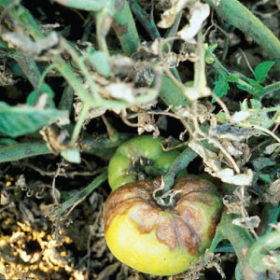 |
Blight Disease (a.k.a. Phytophthora Blight, Crown Rot, Fruit Rot)
Learning Downloads: Disease Control: Early Blight, Disease Control: Late Blight Symptoms: Attacks and leaves brown spots on roots, stems, leaves and fruit. Wilting and death occur right when reaching the fruiting stage. Fruit rotting. Cause: Occurs naturally in soil with high moisture, poorly drained soils. Control: Once spotted remove all plants from soil and burn. Practice crop rotation. Avoid poorly drained soils. Fungicides can be used as a prevention. |
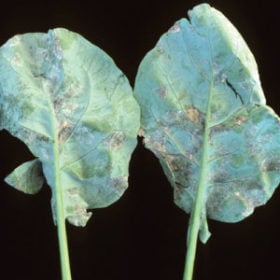 |
Downey Mildew Disease
Learning Download: Disease Control: Downy Mildew Symptoms: Blush tinge on upper part of leaves, maturing to small yellow spots on upper side with white fluffy growth underneath. Cause: Occurs in cool temperatures and high humidity. Control: Plant debris should be removed and burned. Space plants for good air circulation. Fast draining soil. Fungicides should be used under wet conditions for prevention. |
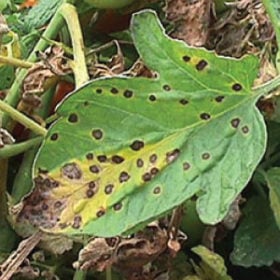 |
Leaf Spot Disease
Learning Download: Disease Control: Leaf Spot Symptoms: Attacks leaves of plants. Black tar looking ripples in the middle of brown spots on leaves. A fungus disease. Cause: Most damages occurs in spring. Wet weather invites fungus spores to reproduce. Control: Does not harm actual tree. Remove infected leaves. Keep foliage dry if possible. Use organic copper fungicide if needed. |
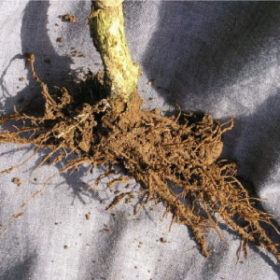 |
Root Rot Disease
Symptoms: Attacks plant roots. Plants will be stunted and stop growing. Foliage will be dull. Sometimes leaves turn yellow and wilt. Plant may have to be lifted from ground to discover root rot. Causes: Damp or dry soil can cause this. Certain funguses will cause as well. Control: Increase soil drainage. Avoid dense, clay soil. Fungicides have been shown to help but increase soil drainage is best option. |
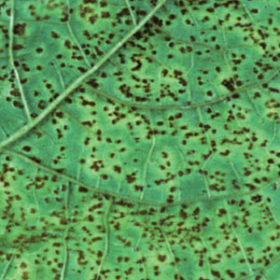 |
Rust Disease
Symptoms: Pustules on leaves occasionally on the other aerial parts. Pustules may be orange, yellow, brown, black or white. Causes: Caused by fungus disease. Control: Pick off infected plant parts and burn. Use organic copper based fungicides. |
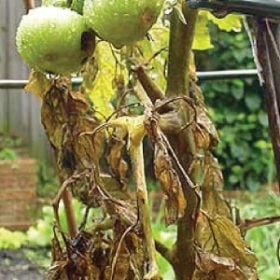 |
Verticillum Wilt Disease
Symptoms: Leaves turn yellow and dry up. Starts from bottom and moves up. Causes: Caused by soil borne fungus and can affect several different vegetables. Fungus can persist for years. Affects uptake of water and nutrients eventually killing the plant. Control: Crop rotation and resistant varieties is important. Remove affected plants and burn. |
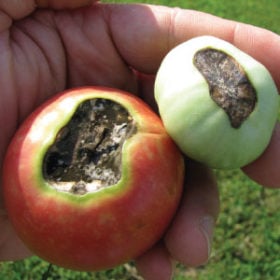 |
Blossom End Rot
Learning Download: Disease Control: Blossom End Rot Symptoms: This is a very common occurrence on tomatoes and peppers. Fruits start to rot from bottom up. Looks like a brown, ripply skin. Causes: A couple things cause this. Dry weather following wet spell. Insufficient calcium in soil. Control: Mulch around tomatoes to even moisture. Add lime to the soil. |
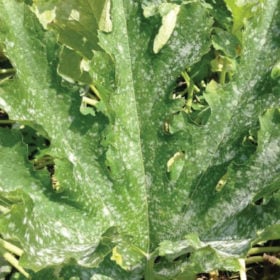 |
Powdery Mildew Disease
Learning Download: Disease Control: Powdery Mildew Symptoms: Starts off with small white powdery looking dots on leaves and will continually worsen as time goes on. Will attach beans, beets, carrots, cucumbers, eggplant, lettuce, peas, peppers, pumpkins, tomatoes and more. Cause: Damp, hot weather can cause powdery mildew but is not dependent on these factors. Control: Planting varieties that are better resistant to powdery mildew is important when growing in areas that have had it in the past. Plant in full sun. May require fungicide treatment. |
